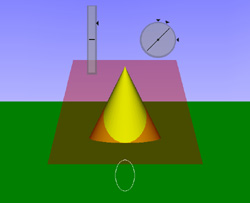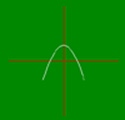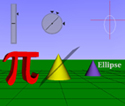


 |
Click here to explore conic sections with our VRML 2.0 model (26K). Two viewpoints (Entry and From Above) are preset in this scene. To control the intersection of the plane with the cone, use the two sliders. The bar controls the vertical placement of the plane and the circle controls the angle of the plane with respect to the cone. Some settings are preset and can be selected by clicking on the arrows. Depending on the type of computer you are using, you may see the pointer (cursor) change when it is above the arrows, indicating that they are active. You also can click on the slider lines and drag them to change the position continuously. The spinning of the cone and plane can be turned on or off by clicking on either object. |

| Click here to explore conic sections with a NEW version of our VRML 2.0 model (100K). This version has a FlyRide animated viewpoint and the top of the blue cone can be "blown off" by clicking on the cone. To put the top back on, click on the word Ellipse, which describes this cone-plane intersection. The plane intersecting the center (yellow) cone still spins when you click on either the plane or cone and stops when you click again. |
|
|
Return to VRL Home Page http://www-VRL.umich.edu |
|
Return to Project Overview |